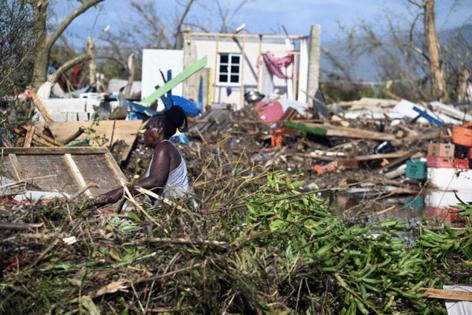Satellite data reveals Hurricane Melissa damage in Jamaica
Published in News & Features
As Hurricane Melissa sweeps past Bermuda into the North Atlantic, new satellite data of Jamaica has revealed devastation for tourist center Montego Bay and much of the Western part of the country.
At least 40% of the buildings and roads in the worst-hit areas on the island were severely damaged, according to a Bloomberg News analysis of satellite data processed by the Earth Observatory of Singapore.
The hurricane caused the most destruction in Jamaica’s western region, which includes the devastated town of Black River and the heavily-damaged tourist center of Montego Bay. Analysis of satellite data shows that Saint James, Westmoreland and Saint Elizabeth parishes were most affected.
“I have never seen anything like this before,” said Kerry-Lee Lynch, head of United Way of Jamaica, who drove from Kingston to Montego Bay on Wednesday past downed trees and power poles. She said the damage from Melissa was worse than the hurricanes that devastated the island in years past. “This is more extensive damage than what I saw from Ivan or Beryl. It’s horrific.”
In Jamaica, soldiers on foot have had to use machetes to cut their way through intertwined bamboo plants to reach cutoff communities along the island’s western edge, authorities said during a news briefing on Thursday. Blackouts remain a problem with almost 72% of customers lacking electricity.
“There are entire communities that seem to be marooned and also areas that have been flattened,” Dana Morris Dixon, the country’s information minister, said. “Jamaica is really broken.”
Melissa also tore through the country’s farming heartland, where staples such as yams and tomatoes are grown for the entire country. Bananas are especially vulnerable during storms because the trees they grow on are fragile, said Damien King, executive director of the Caribbean Policy Research Institute in Kingston. “It has devastated agricultural areas, and that is going to manifest itself in terms of shortages and food prices,” he said.
The record-setting storm made landfall on Tuesday near New Hope, Jamaica, as a Category 5 hurricane packing winds of 185 miles (298 kilometers) per hour. It was the strongest storm to hit the island in more than 170 years of record keeping. At least 19 people have been killed, according to Agence France Presse, citing comments by the information minister to local media late Thursday.
Authorities are still assessing the full extent of the damage, but economic losses are already estimated to be at least $8 billion, said Chuck Watson, a disaster modeler at Enki Research.
Much of the economic toll is likely concentrated in Jamaica due to widespread flooding, he said, with current estimates expecting around $7.7 billion in losses — more than one-third of the island’s gross domestic product. The storm missed the most densely populated islands in the Bahamas, he added, which will likely limit losses to $25 million. Meanwhile, Bermuda faces up to $150 million in impacts depending on the storm’s track as it exits the Caribbean.
“It may be days or a week or more before we have a more complete picture of the scale of destruction,” said AccuWeather meteorologist Jon Porter.
The first step with large buildings like hotels is to assess the stability of the structures, then set up generators and restore air-conditioning to stop mold from growing, said Scott State, chief executive officer of infrastructure decommissioning firm NorthStar. The company provides disaster recovery services and worked in Jamaica after Hurricane Beryl last year. “If there’s not structural integrity, then you’re looking at removing these facilities to the ground or below,” he said.
Melissa passed Bermuda early Friday morning and is moving northeastward at hurricane strength, according to the U.S. National Hurricane Center. Now a Category 1 storm with wind speeds around 90 miles per hour, Melissa is expected to rapidly degrade into a strong extra-tropical cyclone and continue weakening as it moves into colder waters in the North Atlantic, U.S. forecasters said.
Residents in Bermuda took shelter as the storm flanked the island to the west, but local newspaper The Royal Gazette reported no major damage or disruptions. Melissa could bring strong wind gusts and heavy rain to Newfoundland as it passes nearby Friday night.
The last remaining hurricane warning, for Bermuda, was canceled early Friday morning.
Melissa also caused severe damage in Haiti and Cuba. The storm left at least 30 people dead in Haiti, according to the Associated Press. The U.S. is prepared to provide humanitarian assistance to Cuba, U.S. Secretary of State Marco Rubio said in a statement.
Kingston Airport reopened on Wednesday for humanitarian flights and Thursday for commercial flights, while Montego Bay Airport remains closed, according Grupo Aeroportuario del Pacífico, which operates the facilities. Aid began to flow into Jamaica from a variety of countries, with France sending a humanitarian aid ship that carried water purification kits and basic food supplies.
Two specialized U.S. search-and-rescue teams were scheduled to deploy to Jamaica on Thursday from fire departments in Los Angeles County and Fairfax County, Virginia. Officials said the teams — which include 68 crew members and two canine units — will help with recovery efforts and coordinate with the State Department on assessing local needs.
----------
—With assistance from Stephen Wicary, Veena Ali-Khan, Alex Newman, Alexandre Rajbhandari, Lauren Rosenthal, Peter Frontini and Christopher Cannon.
©2025 Bloomberg L.P. Visit bloomberg.com. Distributed by Tribune Content Agency, LLC.







Comments